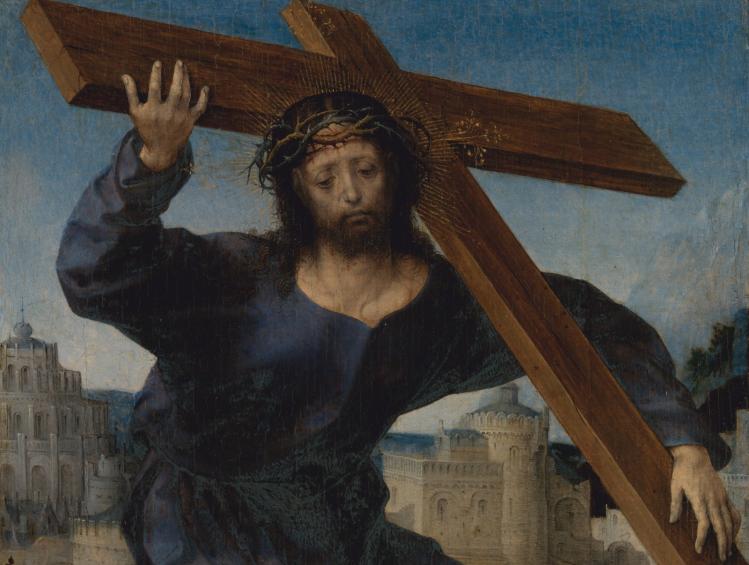
In early 2011, Fr. Daniel Berrigan, SJ asked me and my spouse to come to Manhattan. We were to join him for the annual Pax Christi Stations of the Cross, which takes place in New York every Good Friday. I had never heard of the event, nor had I read Berrigan’s book, Stations: The Way of the Cross.
In this moving collection of poems (with terracotta reliefs by Margaret Parker) the streets of lower Manhattan constitute a modern-day Calvary, the fallen homeless recalling Christ’s three falls on the way to the Crucifixion. Those still standing form a march of the living dead. There are beggars on buses, poor people pushing their belongings in shopping baskets, women living in the underground subway stations. We follow them “with every step we take in public, in every neighborhood,” tracing the via dolorosa of John Doe, as he picks up his cross on the corner of Second Avenue and Nameless Street. At the Ninth Station, John Doe falls for the third and final time—“John-without-any-dough,” we might call him, fallen, penniless, and abandoned. “These homeless,” Berrigan writes, “live out in dreadful, literal detail, the poverty we would rather conceal from God [and] from ourselves.” But they do so with great dignity and faith, inspiring compassion, and transforming the via dolorosa into a “school of mercy.”
So on April 22, 2011, together with Berrigan, we began our Stations of the Cross in Dag Hammarskjöld Plaza near the United Nations on the East Side of Manhattan. There, we prayed for peace among nations, a world without war, and the abolition of nuclear weapons. Later, at the Times Square Army Recruiting Station, we repeated these prayers for all those who die on the cross of militarism, invoking God’s mercy on soldiers in all armies, prisoners of war, and those held in solitary confinement. In front of a movie theater, we prayed to stop the glorification of violence, and for the estimated 1 million annual victims of sexual trafficking. Standing next to several expensive restaurants, we prayed for those who walk the streets hungry, the 47 million Americans dependent on food stamps, the twenty thousand homeless children in New York City, and the dozens of individual homeless people we passed on our way. In front of a bank, we prayed for economic justice: not only for an end to financial greed and the relentless quest for profits, but for a fairer distribution of wealth, for health care, and for a living wage for all.
When we began our walk near the UN, there were roughly two hundred of us. We distributed handouts to anyone who asked what we were doing. Our fliers read:
We are praying here on 42nd Street so that we recall that Jesus’s Way of the Cross was a public event. We stop and pray along this street at fifteen places that reflect the suffering and injustice in our world. We remember that Jesus welcomed all to the table—a table of love and forgiveness, of peace and reconciliation, of care and compassion; a table representing the belief that all are welcome regardless of race, creed, gender, sexual orientation, place of birth, and class. We walk with victims of genocide and abuse, discrimination and poverty, women and children, the unborn and those condemned to die. We invite you to join us, no matter what your faith. Let us pray together for peace in our hearts and in our world.
By the time we finished, at the fifteenth station, our number had grown to six hundred.
Berrigan’s non-dualistic vision allowed him to find Christ in the wretched of the earth: the imprisoned, the homeless, the destitute, the dying, the outcasts, the marginalized, the bullied, the broken, and the desperate. They too are members of Christ’s mystical body, and they will always be with us. “Sometime in your life, hope [that] you might see one starved man, the look on his face when the bread finally arrives,” writes Berrigan in his book Love, Love at the End. “Christ is merciless about the poor,” he continues:
He wants them around—always and everywhere. He’s condemned them to live with us. It’s terrifying. I mean for us, too…. Like the look of Christ, the poor man strips us down to the bone. And, then, if we’re lucky, something dawns—even on us. Why, we’re the poor. The reel plays backward, everything’s reversed when the Gospel is in the air…. But for the poor, we’d never know who we are…Christ guaranteed it—I don’t know why. The poor you always have with you. Like a marvelous majestic legacy of God. His best possession, in our hands. Undeserved like the Eucharist…They were the workers of corporal mercy…. They save even us. They carried fresh bread to stale lives.
That Good Friday in Manhattan in 2011, in the faces of the poor, Christ indeed gave us bread to eat.
Please email comments to [email protected] and join the conversation on our Facebook page.
Share
Previous Story
Letters | An exchange about the Eucharist as symbol, progress at seminaries
Next Story
All One Body